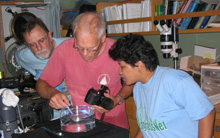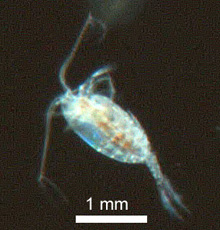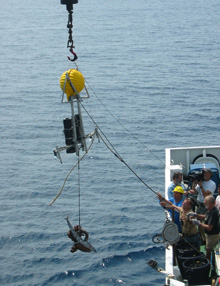The RopeCam dangles above the sea on its way to the bottom on October 6. The video camera in its waterproof housing points directly down at the bait, a whole king mackerel tied to lead weights. The yellow float above the camera rig will keep the camera aiming at the fish when it is lying on the sea floor. Image courtesy of 2007: Exploring the Inner Space of the Celebes Sea.
ROV Operations
October 6, 2007 — Log 2
Hildie Nacorda
Research/Technical Assistant
Marine Science Institute
University of the Philippines
The ship is off Mantabuan Island in Tawi-Tawi (4º 57.9’N, 120º 11.30’E). I learned that during the night we drifted some distance from where we were supposed to be, so it took about an hour to return to the site selected for today’s sampling. It is another sunny day with a slight breeze, thin clouds, and a calm sea in an area with no observed “significant incidents” (as per the Philippine Navy) – among the things one would look for during an expedition in this part of the world. After revisions of the schedule, the order for the day will proceed from first, the deployment of the RopeCam, baited with one big tangingue (king mackerel), followed by bluewater diving, the deployment of the remotely operated vehicle (ROV), its retrieval from the deep after four hours, mesoplankton sampling with the bongo nets, and finally, the night bluewater dive. A busy day!
Everything amazes me here: the science experts, world-renowned film-makers and photographers, the technology they brought all the way from the U.S.; the interesting finds of the divers, RopeCam, and the ROV (some of the video they record astonishes the experts on board); even the coordination of the boat crew with the scientists to make things happen every day. There are certainly new things to see and learn every hour.
I took a photo of the RopeCam while it was still hanging from the winch wire. The unfortunate mackerel was tied to the RopeCam’s dead weight and the rig was buoyed with a bright yellow float. It could stay out as long as five hours, according to Mike Cole. Unlike the ROV, the RopeCam is not set up with real-time output on the monitor in the mess hall, so we must wait until it is recovered to find out if any animals came in to devour the bait. We watched a video a couple of days ago in which the RopeCam documented the sharks at Rongelap Atoll that came into the camera’s field of view to feed on the bait. Sharks are top predators in the food chain, and their occurrence indicates that the marine waters are in a healthy state.
The ship continues underway with other operations while the RopeCam is down. We can find it again by locating the “high flyer” tied to the RopeCam’s tether at the surface. The high flyer was improvised from a long PVC pipe weighted at one end and floated with large empty 5-gallon drinking water bottles containers. A radio transmitter with a 12-mile range is lashed to the upper end, and the line to the RopeCam’s rope is stitched with 4 bright orange floats.
…. Once the RopeCam was retrieved, we crowd impatiently around a small monitor in the science lab to find out what the camera saw. No shark approached our bait on this first launch of the RopeCam. Interestingly though, we saw rattails (family Macrouridae) sniffing the bait, a curious eel, and bright red-orange shrimp. Everyone watches in awe, I guess more so because we could see the bottom and what it is like – sandy with silt, some re-suspension, and with evidence of the presence of life, e.g., small mounds of burrowing ghost shrimps. Mike Cole told me that the RopeCam is programmed in advance to shoot 3-minute continuous sequences at intervals of 20 minutes, so the photographic record covered approximately 36 minutes during its 4-hour deployment.
Conditions continue to be ideal for bluewater diving. The National Geographic video team, Nick Caloyianis and Lee Caughron have recorded the dives both from the support rubber boat and underwater. Michael AW documents the dives with still photos. The scuba divers have found interesting animals – various ctenophores and medusas, a juvenile cerianthid anemone, siphonophores and salps. On the deck, most of the collected animals are identified to genus by Bill Hamner, Larry Madin, and Erich Horgan as we look on. Some individuals are filmed in the plankton kreisel, a PlexiGlas holding tank designed for observations of these water column invertebrates. Bill caught one juvenile fish – probably a carangid according to Joseph Rayos of BFAR-NFRDI. Each time they dive we wonder, “What will they find this time? And how different will the animals be that they see at night from the ones they encounter in sunlight?”
When you think of the open ocean, you think of clear blue water. For the Celebes Sea, "clear blue" is only skin-deep because much of its water contains a scatter of marine snow, appearing as a blizzard of fast moving white particles in images recorded by the HD camera on the ROV when it is on the move. Watching the live video on the monitor in the mess hall, we noted fragile mucus “houses” of larvaceans, tiny fish, medusae and siphonophores, strange pelagic isopods that look like rather like spiders, and occasional squids, including a fancy one called a cockatoo squid. Joe Caba, the ROV pilot, almost caught the cockatoo squid with the ROV’s suction sampler, but it jetted away at the last second.
The ROV also records temperature-salinity profiles from the surface to its maximum depths. It has been down to 2,800 meters (a delight to oceanographers!). Temperature in the surface layer has been 28º C, decreasing to 8º C at 400 meters (m) and to 3º C from there down to the maximum depth. Salinity varies between 33 and 36 down to 500 m and remains about 35 in deeper water. We do not expect these profiles to change much in the coming days.
Bill Hamner, Larry Madin, and Hildie Nacorda (from left to right) admire the polychaete worm caught by the ROV in its October 6 dive. The polychaete’s body was 85 millimeters (mm) long and its tentacles were 75 mm long. Image courtesy of 2007: Exploring the Inner Space of the Celebes Sea.
On the October 6 dive we saw more life on the sandy bottom of the sea. At 2,041 m the ROV found sea pens, a brittle star, a few other kinds of sea stars, a sea cucumber, and a couple of fish. One of the scattered-rocks areas sheltered a fish and some trash. (What a shame!) On the ROV’s ascent Bill Hamner spotted a berried isopod (carrying eggs). Russ Hopcroft and the ROV pilot spotted 3 polychaete worms within 30 m of the bottom and successfully collected them. These were held in separate plastic containers until retrieval on board. I recognized the extremely large polychaete worm — the largest marine specimen by far that I have seen alive!) as a member of the family Onuphidae, and it caught everybody’s attention. Larry Madin and Michael AW took turns in taking photos of the worm in its ambient cold water. The other two, smaller, specimens did not come up alive, so they were immediately preserved for study. Russ Hopcroft believes that one of these was also an onuphid, and I recognized the other as a representative of family Glyceridae. Too bad I did not bring a polychaete taxonomic key on board!




























